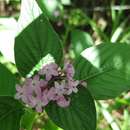en
names in breadcrumbs


Pentas is a genus of flowering plants in the family Rubiaceae. The genus is found in tropical and southern Africa, the Comoros, Madagascar, and the Arabian Peninsula.[1]
The plants have hairy green leaves and clusters of flowers in shades of red, white, pink, and purple. Pentas are attractive to butterflies and hummingbirds. Some species are commonly cultivated and can be grown in pots and baskets. Species such as Pentas lanceolata can withstand full sunlight and need little to no care, growing even in locations that are dry and hot.[2]
Pentas is a genus of flowering plants in the family Rubiaceae. The genus is found in tropical and southern Africa, the Comoros, Madagascar, and the Arabian Peninsula.
The plants have hairy green leaves and clusters of flowers in shades of red, white, pink, and purple. Pentas are attractive to butterflies and hummingbirds. Some species are commonly cultivated and can be grown in pots and baskets. Species such as Pentas lanceolata can withstand full sunlight and need little to no care, growing even in locations that are dry and hot.